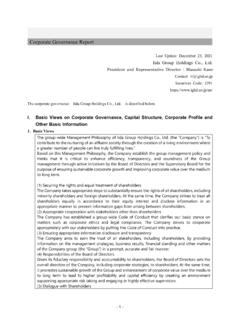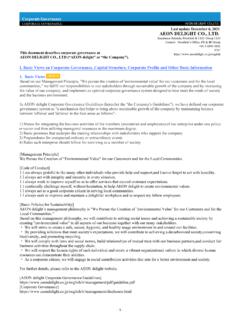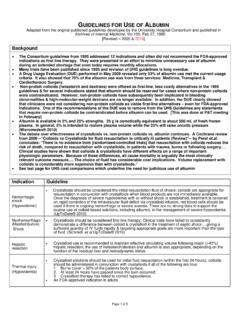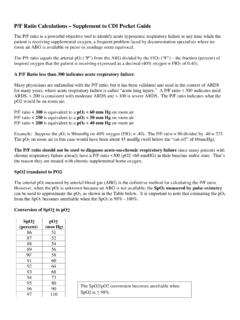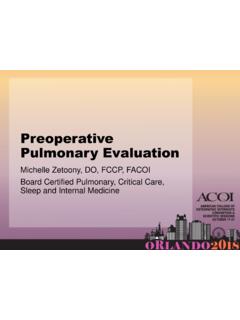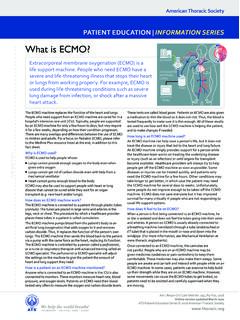Transcription of 20220405 Business Briefing for Institutional Investors
1 April 6, 2022. Company Name: HEALIOS Representative: Hardy TS Kagimoto, Chairman & CEO. (TSE Growth Code: 4593). Business Briefing for Institutional Investors HEALIOS held a webinar to present an update on its Business to Institutional Investors in Japan. The meeting agenda is provided below, and the presentation materials are available for viewing. HEALIOS Business Briefing for Institutional Investors Date and Time: Tuesday April 5, 2022, 10:00-12:00. Description: 1. Introduction Chairman and CEO. Hardy TS Kagimoto, MD. 2. Overview and Current Status of Executive Vice President CMO (Chief HLCM051 Clinical Trials Medical Officer). Masanori Sawada, MD, PhD, MBA. 3. iPSC Regenerative Medicine Executive Officer Research field eNK cells & UDC Kouichi Tamura, Briefing materials: attached Contact: Department of Corporate Communications, HEALIOS E-mail: 1.
2 Overview and Current Status of HLCM051 Clinical Trials Company HEALIOS Executive Vice President CMO (Chief Medical Officer). Date April 5, 2022 Masanori Sawada, MD, PhD, MBA. HLCM051 ards : Target Disease acute respiratory distress syndrome or ards is a collective term for respiratory failure that occurs suddenly in critically ill patients (mainly due to severe pneumonia, sepsis, trauma, etc.). Activated inflammatory cells run amok and attack the lungs. It is a disorder with a very high mortality rate (30 ~ 58%) and a poor prognosis, for which there is a need for novel therapies that can improve patient outcomes. At present, there are no therapeutic drugs that can make a direct improvement to a patient's vital prognosis when ards develops. The only symptomatic treatment for respiratory failure includes artificial respiration.
3 Time-dependent change in CT image in ards affected lung ECMO. Artificial Respiration Ichikado K BMJ Open. 2012 Mar 1;2(2):e000545. HEALIOS All rights reserved. 2. HLCM051 ards : Overview of Cell Therapy The allogeneic bone marrow-derived Multipotent Adult Progenitor Cell product (HLCM051) is expected to restore damaged lung tissue and improve respiratory function by reducing inflammation, regulating immune function, promoting angiogenesis, and protecting and repairing damaged cells and tissues. Partner Company: Athersys, Inc. Head Cleveland, Ohio ( ). Office NASDAQ ATHX. Developed Stem cell product: Products MultiStem proprietary . (Source) Based on materials provided by Athersys HEALIOS All rights reserved. 3. HLCM051 ards : Multiple Mechanisms of Action (Source) Athersys HEALIOS All rights reserved. 4. HLCM051 ards : Multiple Mechanisms of Action Intravenous HLCM051 first reaches the lungs.
4 It restores lung tissue and improves respiratory function by promoting inflammation reduction, immune regulation, and protection and repair of damaged cells and tissues. (Source) Ware et al. NEJM 2000; 342: 1334. HEALIOS All rights reserved. 5. HLCM051 ards : ONE-BRIDGE Study Phase II study investigating the efficacy and safety of HLCM051 in pneumonia induced ards . patients ards trial cohorts Cohort 1 : Patients with pneumonia-induced ards . HLCM051. negative 20 Efficacy and safety evaluation ards Random 2 From April 2019 to March 2021. COVID-19. : Patients 1 Standard Primary endpoint: Ventilator free days (VFD) at Day 28. Test Secondary endpoint: Mortality (at day 28, 60, 90, 180). therapy 10. Cohort 2 : Patients with pneumonia-induced ards caused by COVID-19. positive HLCM051 Safety evaluation From April 2020 to August 2020.
5 5. Patient enrollment of COVID-19 pneumonia-derived cases (Cohort 2) was performed separately from the conventional clinical trial administration group (Cohort 1). HEALIOS All rights reserved. 6. HLCM051 ards : ONE-BRIDGE Study Results at 180 Days Post Administration Cohort 1. No safety concerns. The HLCM051 treated group demonstrated a 9-day higher median VFD than the standard therapy group. The treated group saw a 39% reduction in mortality as compared to patients treated with standard therapy. Cohort 2. No deaths, no safety concerns. The ventilator was withdrawn within 28 days for all five patients and in three days or less for three of these patients. Cohort 1 Cohort 2. HLCM051 Standard therapy HLCM051. Primary Endpoint Primary Endpoint VFD (the number of days out of 28. during which a ventilator was not 20 days 11 days Safety No safety issues used for the patient).
6 Secondary Endpoint Secondary Endpoint Mortality VFD 25 days (180 days after administration). Mortality (180 days after administration). 0%. HEALIOS All rights reserved. Source in-house data 7. HLCM051 ards : Comparison with Historical Data Comparison with historical data was a secondary efficacy endpoint of the study protocol Data source reported in Scientific Reports (Sci Rep. 2021; 11: 20051.) in October 2021. Matching comparison was performed with the data from the paper on which the study design is based. ONE-BRIDGE Study Forward-collected historical data HLCM051(20 subjects) (104 subjects). Matching by Propensity Score Abstraction 20 subjects were selected from historical data and compared to group HLCM051 of ONE-BRIDGE study (VFD, Mortality). HEALIOS All rights reserved. 8. HLCM051 ards : Comparison with Historical Data Consistent with the ONE-BRIDGE study, VFD was prolonged and mortality improved.
7 In the matched historical data comparison, the VFD was prolonged by days (mean), and the mortality rate was lower (reflecting a 56% decline in mortality as compared to the historical data group). Compared with historical data P= Matched historical HLCM051. data Primary Endpoint P= VFD (the number of days out of 28. during which a ventilator was not . used for the patient) days Secondary Endpoint . P= Mortality (180 days after administration) HLCM051 Matched Historical N=20 Data N=20. Source in-house data HEALIOS All rights reserved. 9. HLCM051 ards : Development Status ONE-BRIDGE Study Regenerative medicine product pre-application consultation with the PMDA was conducted at March end 2022. Healios was advised that when making a future application for approval for the ards indication, it needs to add certain supporting August 2021 data to the proposed application data package.
8 Consultations with Announcement of top-line results the regulator are ongoing. April 2019 March 2021. First patient enrolled Patient enrollment completed Data analysis Preparation Patient enrolment Approval /. for Application Launch Application *HLCM051 has been designated as an orphan regenerative medicine product for use in the treatment of ards by the Ministry of Health, Labor and Welfare. HEALIOS All rights reserved. 10. HLCM051 Ischemic Stroke: Overview Ischemic stroke is caused by a blockage of blood flow in the brain that cuts off the supply of oxygen and nutrients, resulting in tissue loss. The annual number of cases in Japan ranges from 230,000 to 330,000. It is estimated that of bedridden patients and of persons who were in need of care were affected by ischemic stroke. Treatment in Accordance with the Period After Onset Period after onset 10h 20h 30h 40h Clot-dissolving agent*1.
9 There is a time limit because of the risk of Mechanical reperfusion cerebral hemorrhage (Source) Athersys *2. HLCM051 Possibility as a new alternative 1 Dissolves blood clots in the brain vessels 2 Insertion of the catheter into a blood vessel and recovery of the thrombus directly with a wire. HLCM051 Therapy Could Greatly Extend the Treatment Window for Stroke Patients (Note) This material was prepared to explicitly describe the major therapeutic options for ischemic stroke and their treatment window periods after onset. Appropriate treatments are conducted according to patients' conditions and classification of their symptoms. Experimental or investigational treatments HEALIOS All rights reserved. not included in the above are also performed. 11. HLCM051 Ischemic Stroke: Mechanism & Neuroprotective Effects in Cerebral Infarction Cerebral infarction leads to activation of the peripheral immune system and release of proinflammatory cells and cytokines from the spleen (atrophy of the spleen).
10 Spleen-induced proinflammatory mediators contribute to exacerbation of blood-brain barrier (BBB) disruption and central nervous system (CNS) inflammation mediated by injurious microglia (M1). Intravenously administered HLCM051 reduces the destruction of the BBB by promoting the release of anti-inflammatory mediators from the spleen while suppressing atrophy of the spleen, and reduces inflammation of the CNS by promoting the environment for nerve cell regeneration. M1 Microglia injurious properties M2 Microglia Protection (Source) Stroke. 2018 May;49(5):1058-1065. HEALIOS All rights reserved. 12. HLCM051 Ischemic Stroke: Mechanism Involving the Spleen Offner et al. focused on the peripheral immune system (especially the spleen) and involvement of the peripheral immune system after acute central nervous system injury and stroke.



